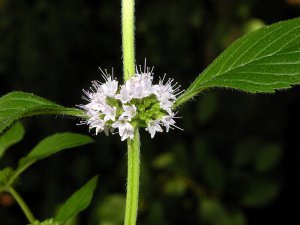An Introduction to Wild Mint:
Mentha candensis, or American Wild Mint, is an extant mint species and Native American Herb commonly found in North America but is also native to East Asia. This can be somewhat confusing since this American native is also called Japanese or Chinese wild mint. It is one of the most sought after American Native Herbs. Another thing to note is Mentha arvensis is another scientific name for a very closely related species of wild mint. Sometimes Mentha candandesis is scientifically referred to as Mentha arvesis within the variety glabrata.
Places where you can spot American Wild Mint:
American Wild Mint can be found in somewhat wet areas, but not areas will long periods of standing water. The edges of rivers can be an excellent place to be on the lookout for some Wild Mint.
Blooming Period:
From the course of July till August, these plants bloom in regions where they are native.
Physical Appearance:
The flowers of this herb or plant are more purple but sometimes also white, and the leaves appear slightly purple, too. The height of the plant can be 17 inches tall. There are spikes at the tips from where the flowers emerge.

Distribution of this Native American Herb:
This plant is well known around the world and grown with enthusiasm. Not only is it abundant in North America or any other place in the west, but it is also grown in eastern countries like China and Japan, taking a lot of interest. The Eastern side of Russia, Siberia, and some parts of the Indian Subcontinent, including Sri Lanka, Nepal, and India. South-East Asian countries such as Malaysia, Indonesia, and the Philippines, plus Indo-China states such as Thailand, Myanmar, and Laos, have also shown a lot of interest. Talking about the North American Regions, we have Parts of both Canada and the United States involved.
When we talk about other places where wild mint is grown, South Africa has a crucial role. South America, also adding Brazil plus Argentina, has taken an interest growing this plant.
The role of American Wild Mint in Cooking & Candy Production:
Considering that menthol has for a significant time always had a tremendous amount of demand the world over, American Wild Mint has become an essential resource for making menthol. Imagine a chunk of the total amount of Mentos completely vanished off of the market because of a lack of menthol being produced; this is how much American Wild Mint means to the world, but that’s not all.
American Mint has also been used to make various oils. Due to its peppermint flavor, we can add it to sweets such as Peppermint Candy Canes during the holiday season.
If you get your hands on their leaves, an ideal way to use them would be too make tea out of them by boiling the leaves (fresh or dried if you dried them in the first place) in water and add sweeteners such as sugar or honey; a healthy, hot and delicious drink will be ready.
The Medicinal Uses of American Wild Mint:
Essential oils have been made from this Native American Herb (the variant found in Japan has been utilized mostly) for the high amount of menthol present within them compared to essential oils produced from other kinds of mint. Eastern medicine prizes menthol, and likewise, American Wild Mint holds great importance for them.
In short it is a useful Native American Herb.
—————————————————————————————————————-
| Written By Muhammad Waleed Raja,
~ Waleed is an avid graphic designer, animator, illustrator as well as freelance writer with an affinity towards nature, art, technology and everything that encompasses gaming along with pop-culture added into the mix. To learn more about him look up his profile on upwork.com ~
—————————————————————————————————————-
Many of our readers find that subscribing to Eat The Planet is the best way to make sure they don't miss any of our valuable information about wild edibles.
See our privacy policy for more information about ads on this site






